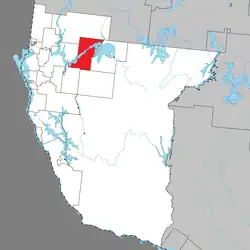Moffet | |
|---|---|
 | |
 Location within Témiscamingue RCM | |
 Moffet Location in western Quebec | |
| Coordinates: 47°33′N 78°57′W / 47.550°N 78.950°W[1] | |
| Country | Canada |
| Province | Quebec |
| Region | Abitibi-Témiscamingue |
| RCM | Témiscamingue |
| Settled | 1936 |
| Constituted | January 1, 1953 |
| Government | |
| • Mayor | Alexandre Binette |
| • Federal riding | Abitibi—Témiscamingue |
| • Prov. riding | Rouyn-Noranda–Témiscamingue |
| Area | |
| • Total | 427.58 km2 (165.09 sq mi) |
| • Land | 340.31 km2 (131.39 sq mi) |
| Population (2021)[3] | |
| • Total | 206 |
| • Density | 0.6/km2 (2/sq mi) |
| • Pop (2016–21) | |
| • Dwellings | 179 |
| Time zone | UTC−5 (EST) |
| • Summer (DST) | UTC−4 (EDT) |
| Postal code(s) | |
| Area code | 819 |
| Website | www |
Moffet is a municipality in northwestern Quebec, Canada, in the Témiscamingue Regional County Municipality. The municipality had a population of 206 as of the 2021 Canadian census.
History
As early as 1910, settlers arrived in the area, but it was not until 1931 that the village developed when a group of settlers from Saint-Zacharie in the Beauce region came and cleared the land. The place was named after Joseph Moffet (1852–1932), an Oblate missionary who had explored the Témiscamingue region and founded Ville-Marie. In 1932, the first sawmill was built, followed by the first forge two years later. In 1936, the Moffet Post Office opened, and the next year, the general store.[1][4]
On January 1, 1953, the Municipality of Moffet was established out of parts of the United Township Municipality of Latulipe-et-Gaboury and previously unincorporated territory.[5] Its first mayor was Emmanuel Gagné.[4]
Demographics
| 2021 | |
|---|---|
| Population | 206 (+10.2% from 2016) |
| Land area | 340.31 km2 (131.39 sq mi) |
| Population density | 0.6/km2 (1.6/sq mi) |
| Median age | 59.2 (M: 60.0, F: 54.0) |
| Private dwellings | 179 (total) 104 (occupied) |
| Median household income | $.n/a |
|
| ||||||||||||||||||||||||||||||||||||||||||||||||
| Population counts are not adjusted for boundary changes. Source: Statistics Canada[9] | |||||||||||||||||||||||||||||||||||||||||||||||||
Mother tongue (2021):[3]
- English as first language: 7.1%
- French as first language: 85.7%
- English and French as first language: 2.4%
- Other as first language: 2.4%
Local government
List of former mayors:
- Michel Paquette (...–2013)
- Eric Dubuque (2013–2017)
- Alexandre Binette (2017–present)
See also
References
- 1 2 "Banque de noms de lieux du Québec: Reference number 41681". toponymie.gouv.qc.ca (in French). Commission de toponymie du Québec.
- 1 2 "Répertoire des municipalités: Geographic code 85075". www.mamh.gouv.qc.ca (in French). Ministère des Affaires municipales et de l'Habitation. Retrieved 2023-12-04.
- 1 2 3 "Moffet census profile". 2021 Census data. Statistics Canada. Retrieved 2022-05-07.
- 1 2 "Histoire". moffet.ca (in French). Municipalité de Moffet. 2018. Retrieved 4 December 2023.
- ↑ "Répertoire des entités géopolitiques: Moffet (municipalité) 1.1.1953 - ..." www.mairesduquebec.com. Institut généalogique Drouin. Retrieved 4 December 2023.
- ↑ "2021 Community Profiles". 2021 Canadian Census. Statistics Canada. February 4, 2022. Retrieved 2023-12-04.
- ↑ "2006 Community Profiles". 2006 Canadian Census. Statistics Canada. August 20, 2019.
- ↑ "2001 Community Profiles". 2001 Canadian Census. Statistics Canada. July 18, 2021.
- ↑ 1996, 2001, 2006 census, 2006 Population and dwelling count amendments, 2011, 2016, 2021